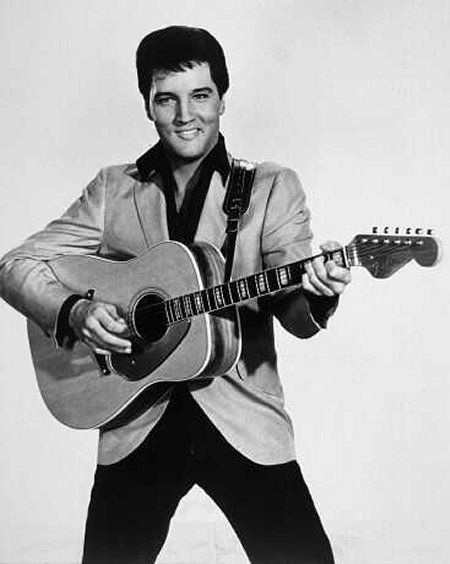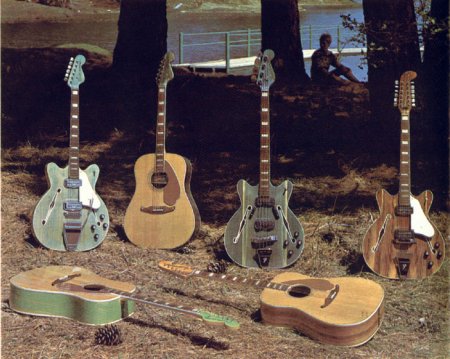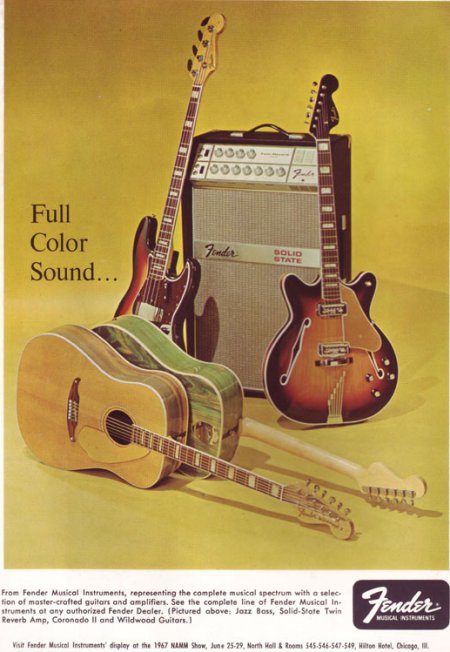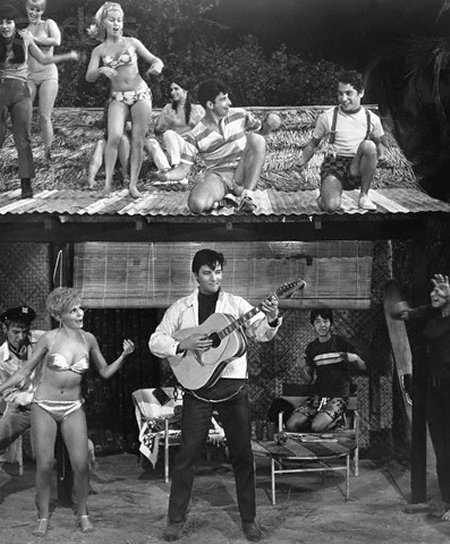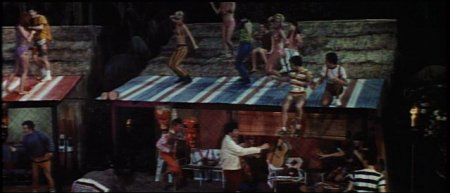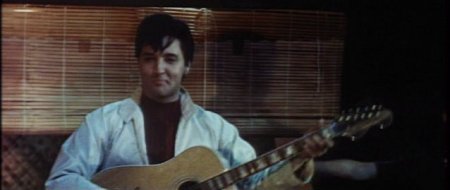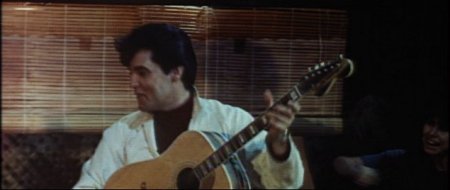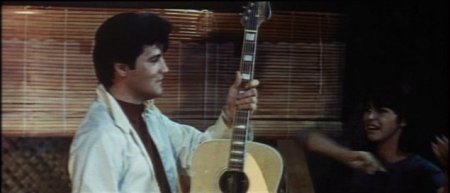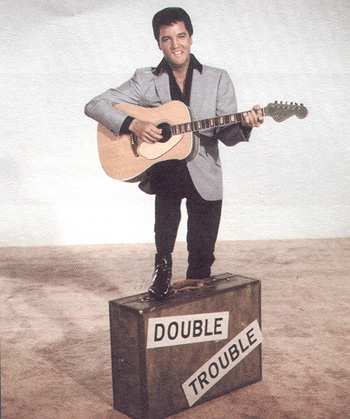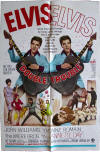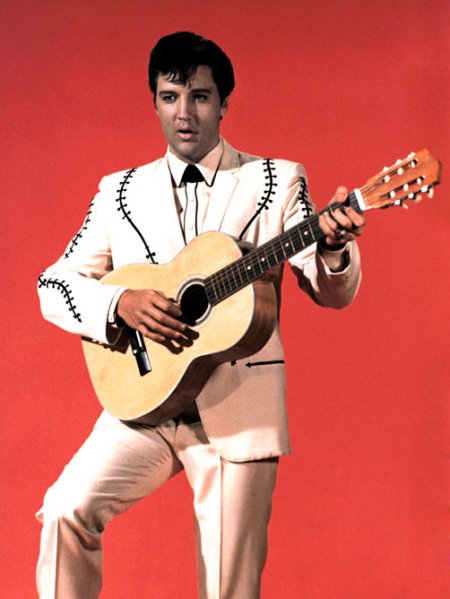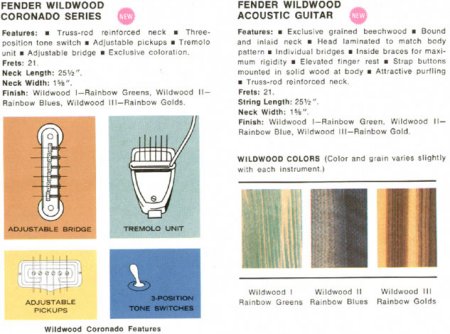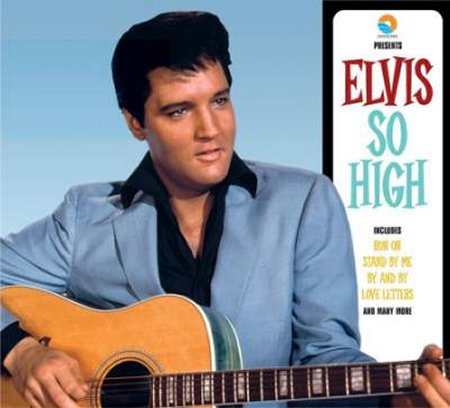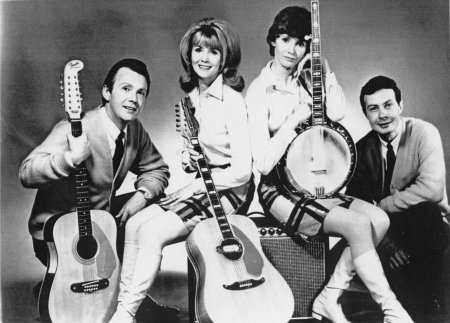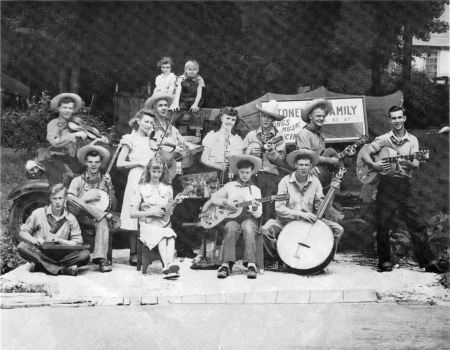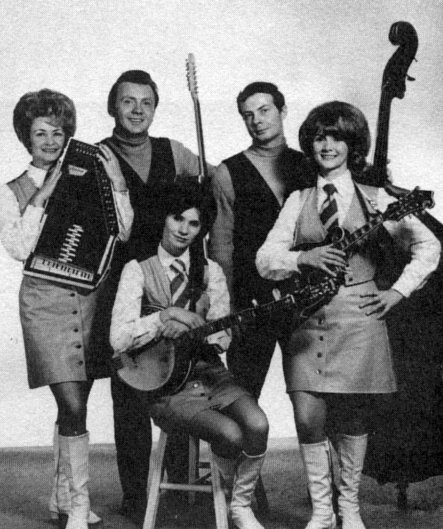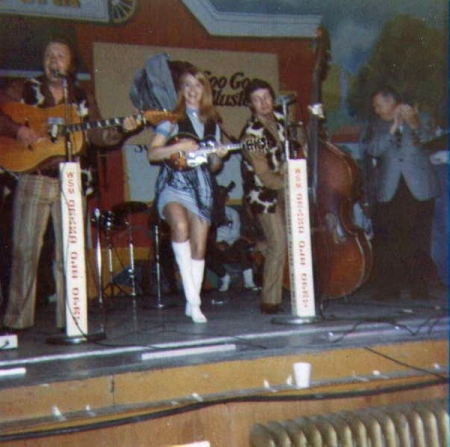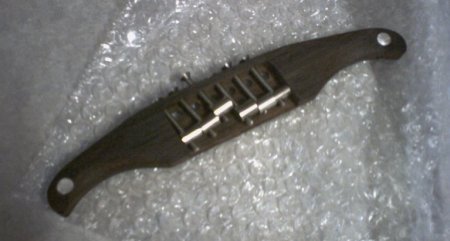 |
1967 Wildwood VI
Fender Musical Instruments began making their first acoustic guitars in
1963. Designed by
Roger Rossmeisl,
the head of R&D at Fender starting in 1962, they incorporated some of
the features established years earlier with
electric guitars like a bolt on maple neck with a
Stratocaster® style headstock and a bolted (and glued) bridge with six
adjustable steel saddles for proper intonation. Their top of the
line model at the time,
the King, had a 25.5" scale length, featured a
maple neck with rosewood fretboard, mahogany back and sides with a solid
spruce top. It was renamed the Fender Kingman in 1965/66.
Also in 1966, Fender began producing a line of guitars using dyed beechwood. Some
accounts say the dye was actually injected into growing trees to produce
the exotic colored grain. Named "Wildwood," it was used as a veneer on
some of the semi-hollow body Fender Coronado line (denoted with the suffix 'II')
and on Fender Kingmans. Though some "Kingmans" were
produced with an all maple headstock, wildwood bodies and had
"Kingman" decals, the Wildwood acoustic
line for 1967 had a wildwood veneer on the face of the headstock
that matched the body and they had bound rosewood fretboards with block
inlays. They were named and decaled as Fender Wildwood I-VI's.
The Roman Numeral suffix on each for the 1967 Model year corresponded to
one of the six colors produced (likely 'I' - Green, 'II' - Gold
and Brown, 'III' - Gold and Purple, 'IV' - Dark Blue, 'V' - Purple Blue
and 'VI' - Blue Green).
After completing the movie "Double
Trouble," Elvis began filming "Clambake"
in March of 1967. In two scenes he is pictured with a Fender Wildwood VI.
Around the same time, several studio photos were taken of Elvis with a
similar guitar and used in promotional materials for the release of
Double Trouble that April. The logo visible in the headstock
appears to be a "Kingman" though the specifications would be
the same.
Though used for promotion, a Fender Wildwood, nor a Kingman, does not appear and was
not used in the actual filming of Double Trouble.
In addition to the Wildwood, Elvis' character in Clambake was
often pictured with a classical guitar. This
particular guitar looks identical to, and may in fact be, the same guitar
held by Memphis Mafia member, Alan Fortas, on stage during the sit-down
session for the 1968 Singer NBC-TV Special
and later smashed during the special's "Guitar
Man/Big Boss Man" medley segment.
By 1968, Fender's literature only listed three colors produced for the
wildwoods with re-sequenced numerals. Fender's initial venture
into the acoustic market was not met with great success and the lines
were discontinued in 1971. It's not clear what further "numeral" scheme Fender later adhered to with these models prior to
being discontinued.
In January of 2004 the Follow That Dream (FTD) label
released "Elvis So High" featuring outtakes from Elvis' Nashville
sessions from 1966 thru1968. For the cover they used an
alternate photo taken in 1967 with the Fender Wildwood VI. In 2005 Fender reintroduced the Fender Kingman
along with the Malibu acoustic
models as part of their California series, though they are now more
conventional style acoustic guitars with glued on necks and bridges with
traditional type saddles. These early U.S.-made acoustics had laminated construction, bolt-on
necks, through-body tension rods and Stratocaster® "styled" headstocks. MODEL YEARS MSRP MATERIALS Copyright ©
Fender Musical Instruments Corporation This
page created
January 30, 2010 and added to the section The
Movie Guitars of Elvis Presley on August 15, 2010
Van Stoneman's 1967 Wildwood II
I didn't take much interest in, or know much about Fender acoustics,
Wildwood or otherwise, until Fender reintroduced their California series
a few years ago and one of my friends at their Custom
Shop in Corona, CA asked me about the one Elvis was pictured with. He had
thoughts of building a replica and knowing I had researched the majority
of Elvis's performance guitars asked me to
look into it. I had only seen the shots used for Double Trouble
and at the time can't even be sure if I had ever even seen Clambake
(see above).
As far as I know he never built the replica but last
year I saw an old Wildwood II listed on eBay several times that
looked rather well worn, played and heavily modified. I thought if I
could get it cheap enough it would make a neat restoration project and
maybe worth using for a page about the one used by Elvis. So
knowing very little about this guitar or its actual condition, I finally
bid on one of the auctions after it had been re-listed at a lower price
that I considered worth the risk of whatever damage to the top that I
suspected the oversized non-original pickguard may be hiding.
When the guitar arrived, the case contained several copies of photos and
an obituary. After a little research I realized that the guitar was
actually one given to Van Stoneman of the Stoneman Family by Fender as
an endorsee in 1967 and used by him for almost three decades. The
guitar had passed to his brother,
Gene
Stoneman, after Van's death and then to
Gene's daughter a few years ago after Gene's death. It was Gene's daughter
and son in law, Robin and Kerry Lewonick, that had ultimately sold it to me on
eBay.
The Stonemans were "born" musicians; how could they be otherwise with recording artist
Ernest Van "Pop" Stoneman for a father and fiddler Hattie Frost Stoneman for a mother? For years, "Pop" Stoneman
supplemented his income as a carpenter with musical performances.
Between 1924 and 1929, he recorded over 200 songs for various labels
including his 1924 hit, "The Sinking of the Titanic." In 1927, while
under contract with the Victor Talking Machine Company, Pop convinced
Victor talent scout Ralph Peer to come to Bristol, Tennessee, to
audition local talent. This session introduced the world to Jimmie
Rodgers and the Carter Family. In 1930, Pop and Hattie's children began
performing and the family moved to Washington, D.C., to find work.1
Being the youngest child in the huge family placed Van Haden Stoneman in a somewhat unusual position. By the accounts of most of the other children, Hattie had her favorites, and Van held this position from the time of his birth. They point out that he got more food, received fewer household responsibilities, and played the all-around role of the “spoiled brat." Nonetheless, Van developed into a versatile and talented musician. He became adept on bass fiddle,
Dobro, rhythm guitar, and both clawhammer and Scruggs·style banjo. In later years he would carry the major share of lead vocals, and his voice also blended well with the others. He became the band's front man.2
The Stonemans, regular figures on local television, got a program on
WTTG-TV Channel 5 in Washington, D.C. Using the 1954 Bill Monroe number
"I'm on My Way Back to the Old Home" as a theme song, the Blue Grass Champs presented a weekly
half-hour of spirited bluegrass and country music. By this time young
Van Stoneman had become lead vocalist and guitar player in the band, a position he would occupy from that time onward.2
They made their first appearance on the Grand Ol Opry in
1962 and in 1965 went to Nashville where they got a contract with MGM Records and started a syndicated TV show. They received CMA’s "Vocal Group of the Year" in 1967.1
At the time, Eddie "Mudge" Miller was head of Fender Marketing in
Nashville and Wade Ray was the artist rep in the area.
The Stoneman's recent recognition and popularity is what likely inspired
one of them or Fender to give Van one of their new Wildwood guitars to
promote. Prior to that Van was regularly playing a Gibson J50
fitted with a DeArmond pickup.
The DeArmond soon found its way on to the new
Wildwood. Van's son, Van, said his "Dad was really picky
about that pickup. He had around 3 or 4 of them and he had his favorites
but one in particular had a lot more lower end to it,hence the angle he
mounted it." Initially he had it mounted under the pickguard,
which tended to elevate the guard and interfere with his playing.
He then cut the pickguard to accommodate it but eventually just removed
the guard and played without it, which as is evident resulted in the
excessive wear.
Van passed away in Murfreesboro, Tennessee, on July 3, 1995 at the age
of 54, from Parkinsons Disease. After Van passed away, the guitar wound
up in the hands of his older brother Gene, in Laurel, MD. In 2005
Gene passed away and his guitars went to his daughter, who ultimately
sold them, or at least the Wildwood on eBay.
Van had at some point replaced the original Fender bridge with a Martin
style bridge and saddle, probably in an attempt to enhance the sound.
The top had several cracks in addition to the excessive wear and hole so
a large black 3-ply pickguard was made and applied to cover the wear.
The pickguard was easily removed, as was the Martin style bridge.
The original two machine screws and bolts that held the original bridge
were apparently salvaged and reused in the newer bridge for
reinforcement.
There were also steel shims added in the neck pocket no doubt as an
attempt to elevate the neck and unsuccessfully lower the action.
When I reinstall it I will use a maple shim at the base of the heel only
to slightly change the pitch. It will also help with tone having
more wood surface area touching between the neck and body.
Using some Naptha and some elbow grease, the top was cleaned up of the
old glue residue with not too much effort. Then repaired a few
cracks in the spruce top that were in the rear center and the outer edge
of the bridge behind the sound hole. I then stored the neck in
place in the case while waiting for other parts.
I was able to locate a proper replica pickguard on eBay that fit
perfectly and actually covered most of the hole worn in the top by Van
while at the same time preserving it's unique originality and
aesthetics.
At first I thought I would have great difficulty locating the proper
Fender bridge for it and contacted
Top Shelf Music
in Buffalo where I knew they had an
older
Kingman in stock. I was hoping to get specifications for the
saddles but to my good luck they actually had a Fender N.O.S. (new old
stock) replacement bridge with the saddles that had been sitting on the
shelf for over 40 years. This particular bridge though was a
later
four-hole mount but they were able to transparently plug the inner two
mounting holes to convert it to the proper two-hole mount I needed.
I temporarily fitted the bridge to the body to mask off the surrounding
exposed area so that I could adequately prepare the top for glue by
sanding and scraping.
I also filled the extra screw and string holes from the Martin
replacement bridge with a little sawdust and would glue and then glued
and clamped the new Fender bridge in place, leaving it set for 48 hours.
After that I bolted tight the nuts from the inside and glued in the dot
inlays to cover the screw heads.
The maple bridge plate that sits under the top where the bridge is and
that the ball end of the strings anchors to ideally should be replaced
because of all the wear and re-drilling through the top but the tension
rod in these guitars make access extremely difficult.
Stewart MacDonalds offers an easy solution to this problem with what
is called a
bridge
Plate Mate, essentially a .032" piece of brass with string holes
that adheres to the bridge plate and is held on by string tension.
Unfortunately they don't offer them with the proper Fender spacing for
these guitars so I had to make my own. I came up with a way to
pull it up to the bottom of the plate and align it underneath properly
using a couple of pieces of twine and spacers threaded through the
string holes since my hands wouldn't reach. I first applied 3M
Super 77 spray adhesive and then clamped it in place for a half hour.
Van's son said that he had eventually installed a
Barcus Berry pickup in the guitar but that later Gene replaced it with
another type of the Barcus Berry transducer pickup. I removed that one opting
for an original DeArmond like Van had which I located, untested, on eBay
for a reasonable price. The original wiring for it was dried up
and cracked and had to be replaced. The clamps needed to hold it
in place were missing but I was able to make an adequate replacement
with a piece of coat hanger.
I installed the DeArmond pickup and jack and then put it
all back together with a small piece of maple shin in the neck pocket to
give it a playable action.
There was an older set of D'Addario strings in the case pocket that were
either Van's or Gene's that I used to set up the guitar with and will
leave it as is for now. It sounds pretty good, both acoustically
and amplified but there are some worn frets causing some notes to mute
(probably why Van used a capo later). If I, or anyone, were going
to be playing this regularly I would consider refretting it but
for the time being I think it is best left with the wear that Van put on it
in his almost 25+ years of playing it.
James V. Roy
1 excerpted from and
according to
The Birthplace of Country Music
Ernest "Pop" Stoneman passed away in 1968. Forty years later, in 2008, he was finally inducted into the Country Music Hall of Fame.
|
|
All photos on this page are the property of the designated persons or company, or else the property of either Scotty Moore or James V. Roy and unauthorized use or reproduction is prohibited. |
